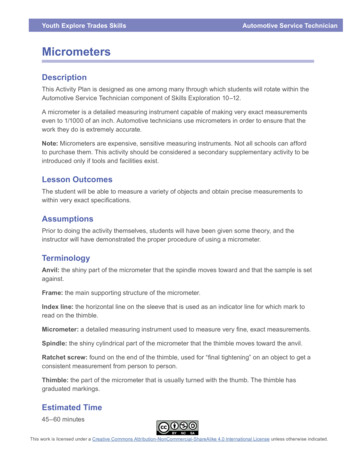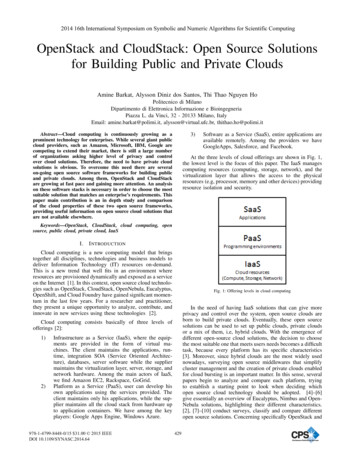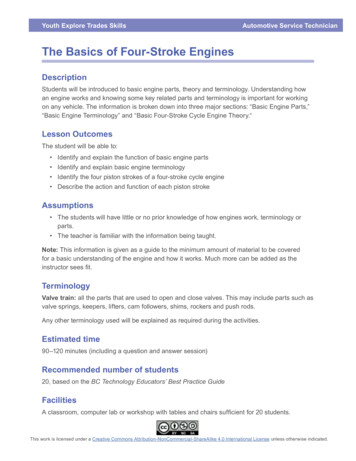
Transcription
Youth Explore Trades SkillsAutomotive Service TechnicianMicrometersDescriptionThis Activity Plan is designed as one among many through which students will rotate within theAutomotive Service Technician component of Skills Exploration 10–12.A micrometer is a detailed measuring instrument capable of making very exact measurementseven to 1/1000 of an inch. Automotive technicians use micrometers in order to ensure that thework they do is extremely accurate.Note: Micrometers are expensive, sensitive measuring instruments. Not all schools can affordto purchase them. This activity should be considered a secondary supplementary activity to beintroduced only if tools and facilities exist.Lesson OutcomesThe student will be able to measure a variety of objects and obtain precise measurements towithin very exact specifications.AssumptionsPrior to doing the activity themselves, students will have been given some theory, and theinstructor will have demonstrated the proper procedure of using a micrometer.TerminologyAnvil: the shiny part of the micrometer that the spindle moves toward and that the sample is setagainst.Frame: the main supporting structure of the micrometer.Index line: the horizontal line on the sleeve that is used as an indicator line for which mark toread on the thimble.Micrometer: a detailed measuring instrument used to measure very fine, exact measurements.Spindle: the shiny cylindrical part of the micrometer that the thimble moves toward the anvil.Ratchet screw: found on the end of the thimble, used for “final tightening” on an object to get aconsistent measurement from person to person.Thimble: the part of the micrometer that is usually turned with the thumb. The thimble hasgraduated markings.Estimated Time45–60 minutesThis work is licensed under a Creative Commons Attribution-NonCommercial-ShareAlike 4.0 International License unless otherwise indicated.
MicrometersAutomotive Service TechnicianRecommended Number of Students20, based on the BC Technology Educators’ Best Practice Guide, 1–3 students per micrometer.If not enough micrometers are available, students could work in small groups with each groupmember measuring a different object.FacilitiesAutomotive shopToolsMicrometers (as many as possible)MaterialsA variety of solid objects of various thicknesses. Ideally the objects should be some sort ofmetal material.Note: Before proceeding through the activity, the instructor should be thoroughly familiar withthe included Resources section of the Activity Plan, in particular the Micrometer Simulatorwebsite.ResourcesMicrometer Caliper—Merriam-Webster Visual Dictionary er 2.phpHow to Use a Micrometerwww.youtube.com/watch?v oHqaLMEHlnEMicrometer aliper-outside-inch-thousandths.htmlWorksheets Micrometer Measurement Exercise Reading a Micrometer Measurement Quiz Micrometer TestEvaluation GuidelinesIncluded is a worksheet that students can be given to record their micrometer measurements.2Youth Explore Trades Skills
Automotive Service TechnicianMicrometersActivity: Using a Micrometer1. Find 10–12 metal objects around the automotive shop and set them up in an organized,distributed manner.2. Have each student measure the thickness of each object and record it on the worksheetprovided.3. Begin by holding the frame with one hand and slowly turning in the thimble with the otheruntil the anvil and spindle almost touch the object.4. Slowly turn the ratchet screw until it tightens around the object and begins to ratchet(makes a clicking sound).5. Lock the thimble in place and read the micrometer setting. Note: Refer to “How to Read aMicrometer” on page 5.6. Record your findings on the Micrometer Measurement Exercise worksheet on the nextpage.ThimbleSleeveRatchet screwLock nutSpindleAnvilFrameFigure 1—Micrometer partsFigure 2—Measuring a pistonYouth Explore Trades SkillsFigure 3—Measuring a brake rotor3
Micrometer Measurement ExerciseNameThickness of Object 1 ( )Thickness of Object 2 ( )Thickness of Object 3 ( )Thickness of Object 4 ( )Thickness of Object 5 ( )Thickness of Object 6 ( )Thickness of Object 7 ( )Thickness of Object 8 ( )Thickness of Object 9 ( )Thickness of Object 10 ( )Date
Automotive Service TechnicianMicrometersHow to Read a MicrometerReading a micrometer takes practice.AnvilSpindleThimbleSleeveFrameTo learn to read the mike you need to understand the thimble and the sleeve.Here we are going to learn to read the micrometer by figuring out the markings on the thimbleand the sleeve.10Index LineSleeve50 Thimble201510The sleeve does not move. It looks like a ruler with 10 numbers. The space between eachnumber is divided into quarters. As the thimble rotates around this sleeve it covers up orreveals the numbers marked on the sleeve.The thimble has numbers and markings on it from 0 to 24. One complete revolution of thethimble (from 0 all the way around to 0 again) moves the micrometer exactly 0.025 inches.Thus each revolution of the thimble moves it to the next “quarter” line on the sleeve.Youth Explore Trades Skills5
MicrometersAutomotive Service TechnicianIt is easy to read a micrometer if you think of themarkings on the sleeve as dollars and quartersand the thimble as Now it gets a little easier to read the mike.0.0090.0080.0070.0060.0050.0040.003To read the micrometer, simply add up the“dollars”, “quarters” and “pennies” in thecorrect order. See example below.The reading is composed of:4 Large graduations or 4 0.1002 Small graduations or 2 0.0258 Graduations on the thimble or 8 0.0010123 0.400 0.050 0.008 0.458"4"100.00850.40060.050Youth Explore Trades Skills
#3Total#2#12. Count the number of small linesbetween the number identified in #1and the thimble edge. Multiply thenumber of lines by .025. Write theIndex lineanswer down on #2.1. Write down the last visible numberbefore the thimble edge on #1.Sleeve05ThimbleReading the Micrometer3. Find the closest number to theindex line on the thimble.Note: The number must be belowthe Index Line. Each line is worth0.001. Write the number down in #3.Name:
0.0750.100#3 0.003Total 0.178#2#1and the thimble edge. Multiply thenumber of lines by .025. Write theanswer down on #2.2. Count the number of small linesIndex line1. Write down the last visible numberbefore the thimble edge on #1.Sleeve05Thimble3. Find the closest number to theindex line on the thimble.Note: The number must be belowthe Index Line. Each line is worth0.001. Write the number down in #3.Reading the Micrometer Answer Key
1.2.3.6.5.4.4.5.6.3.2.1.Measurement Quiz
4. 0.0635. 0.0336. 0.1986.5.4.1. 0.1252. 0.3393. 0.4813.2.1.Measurement Quiz Answer Key
Micrometer Test11 201510ANS4723 4 69105ANS1050ANS1050ANS23 44 6508ANS17220ANSANS150ANS16012145ANS15151359111 24ANS0152010ANS682 30070515581329020ANS1875020ANS78 9105ANS
Micrometer Test Answer Key11 201510.262 ANS4723 4 69105.934 ANS1055.609 ANS01050.375 ANS23 44 53105.455 ANS2002056.248 ANS2344506781510.601 ANS1.837 ANS3420010515.292 ANS650.032 ANS17220.420 ANS.454 ANS152016012145.603 ANS15151350.544 ANS111 2490152010.098 ANS682 30070155813289020.946 ANS1875020.750 ANS78 9105.958 ANS
Reading a Micrometer Measurement Quiz Micrometer Test Evaluation Guidelines Included is a worksheet that students can be given to record their micrometer measurements. Automotive Service Technician Micrometers Youth Explore Trades Skills 3 Activity: Using a Micrometer 1. Find 10–12 metal objects around the automotive shop and set them up in an organized, distributed manner. 2 .











